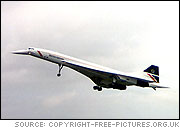Passenger Planes: Concorde

Its futuristic style and Mach 2 speed made it the darling of the jetset
by David Noland
 Concorde Specs
Related Links |
The Concorde supersonic transport is perhaps the most widely recognized aircraft in the world. Its cartoonishly futuristic lines, Mach 2 speed, and aura of posh made it an icon of popular culture. While only the rich could afford a ride, millions of people flocked to airports around the world to see the spectacle of a Concorde landing or takeoff.
Conceived in 1962, the Concorde was an unlikely collaboration of the British and French governments. The first prototype flew in 1969 amid great outpourings of national pride. Commercial service began in 1976.
New York to London in About Three Hours
On a typical flight, the Concorde cruised at Mach 2.02 (about 1,330 mph), more than twice as fast as any other jetliner. It cut New York-to-London flight time from more than seven hours to 3 hrs 15 min. Cruising altitude was nearly 60,000 feet, four miles above the subsonic masses.
The Concorde had a number of gee-whiz technical features never before (or since) seen on airliners: a slender curved delta wing, turbojet engines with afterburners, variable-geometry engine inlets, and an ingenious "droop snoot" that lowered for landing and take-off.
Hefty Price Tag
Its fame notwithstanding, the Concorde was perhaps the biggest financial disaster in the history of commercial aviation. After an investment of more than $4 billion, just 14 planes were sold. The only airline customers were British Airways and Air France, captive national airlines strong-armed into buying nine planes at $50 million apiece. When the two airlines balked at buying more, the governments gave them the last five for the equivalent of $2.00 each.
The rest of the world's airlines concluded that the Concorde, no matter what the price tag, could never turn a profit. Its sonic boom limited it to overwater routes. It burned as much fuel as a 747, but carried only a quarter the number of passengers. But the Concorde eventually found its niche as an exclusive trans-Atlantic time machine for the wealthy elite willing to pay up to $8,000 per ticket.
The Concorde had a perfect safety record until July 25, 2000, when an Air France flight crashed after take-off from Paris, killing everyone aboard. A tire had hit a piece of debris on the runway, causing it to burst. Flying chunks of rubber punctured a fuel tank, causing a leak and subsequent engine fire.
The Last Flight
After being retrofitted with Kevlar fuel tank liners and improved tires, the Concorde fleet took to the North Atlantic skies again in November, 2001. But the 9/11 terrorist attacks had depressed the air travel market, and the 30-year-old planes needed more and more maintenance. The last Concorde commercial flight left JFK and landed in London on October 23, 2003. The era of supersonic passenger flight had ended, perhaps forever.
Concordes are currently on display at the National Air & Space Museum's Udvar-Hazy Center near Dulles Airport; the Intrepid Sea, Air & Space Museum in New York City; and the Museum of Flight in Seattle.








